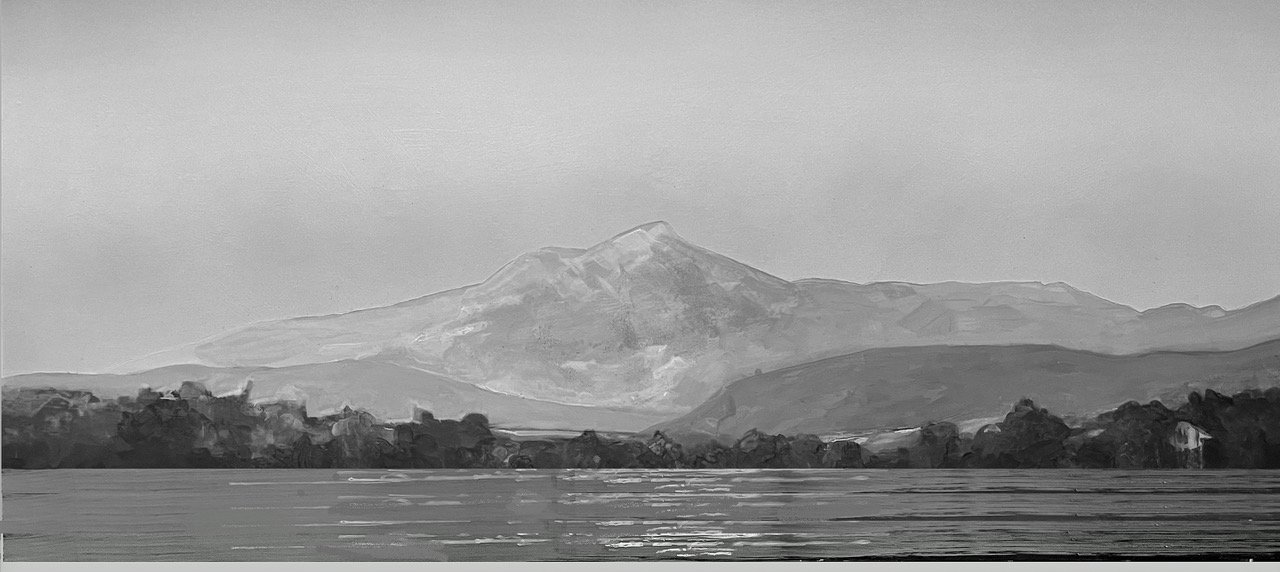The tale of a lake tsunami
April 10, 2024 | By Declan McCabe | The Outside Story Illustration by Adelaide Murphy Tyrol
The sharpest contrast between rivers and lakes is in water movement. While rivers flow inexorably downhill, lake water movement is more subtle. Anyone who has weathered a storm on a lake, however, can attest that less consistent water movement does not mean no water movement at all. In fact, at one point, about 5,000 years ago, it seems a tsunami formed on Lake Champlain.
Geologists use lake sediment cores to study lake conditions from past years. Cores are long columns of lake-floor mud sampled by driving a hollow pipe deep into the lake bed, sometimes from a boat, other times through thick winter ice. The layers of sediment collected in these cores help scientists determine past weather and environmental events.
When turbulent rivers carry sediment into lakes, the relatively still lake waters allow the sediment to settle out and sink to the lake floor. Precipitation and river flow patterns affect how sand and silt accumulate in lake beds over the years.
Spring snowmelt swells rivers dramatically, washing impressive quantities of material from the landscape into a lake. This means that proportionally more sand and silt is deposited early in the year. Wind and wave action keep the very finest of materials suspended in lake water through fall. Lake ice puts a lid on things in midwinter, allowing very fine clay-size particles to settle out.
These seasonal differences in material settling onto lake floors appear as paler and darker stripes, called “varves,” in lake sediment cores. The cores yield a limited perspective, because each one samples just one point on the lake floor.
To get the bigger picture, Middlebury College professor and geologist Patricia Manley and her longtime collaborator and husband Tom Manley broadcast “compressed high intensity radar pulses” (CHIRPs) into the lake water and the sediment below. Detectors record radar pulses bouncing from subsurface varves and use these to build three-dimensional, X-ray-like images of sediments laid down over centuries. These images can record sediment layers as far back as the end of the most recent ice age – and they suggest that tsunamis are part of Lake Champlain’s history.
Varves are not just monotonous layers of crud. Similar to tree rings, there’s quite a bit of variability from year to year. Melt from one year’s deeper snow pack may leave a thicker sandy layer. A year with little lake ice may obscure the clay layer. Extended ice and reduced melt, as happened during 1816, the infamous “year without a summer,” would leave a unique signature with less deposition because of reduced river flows. All of these basin-wide patterns combine to produce a barcode-like pattern of consistently varying relative varve thickness across the lake floor.
To the trained eye, departures from this barcode stand out. Manley and her collaborators noticed a particularly spectacular departure just south of the Bouquet River on the New York side of Lake Champlain. A dramatic upheaval was evident approximately 5,000 years back: a large swath of sediment was missing from a shallow slope. Above and below this gap in the record, there was a normal accumulation of older sediments. Professor Manley found six such masses of displaced sediment, all in the same time frame.
To explain this mysterious dramatic movement of sediment, Manley looked deeper in Lake Champlain. There, she found that tons of sediment had gone downhill in catastrophic underwater mudslides that upended many decades of accumulated sediment, causing the historic barcode to read backways from older sediment down through younger varves that had been rolled under. Above the topsy-turvy misplaced sediment pile, additional centuries of sediment had accumulated in the normal way, encapsulating the record of the mudslide.
So much mud had cascaded downhill that Manley calculated the resulting pressure waves would have produced a tsunami. According to Manley, the wave would have been large enough to wash ashore on the eastern side of Lake Champlain more than 25 feet above the water line.
What might cause sediment that had sat quietly for a millennium to suddenly and destructively take flight? Manley suggests an earthquake was the likely culprit. While researching her findings, she found published records of above-water landslides in the Western Quebec Seismic Zone. The timing of these landslides matched up with that of the Lake Champlain mudslides.
While tsunami risk is not going to keep me off Lake Champlain, I find it fascinating that forces beyond our current perception have shaped our lakes in ways I never would have guessed.
Declan McCabe teaches biology at Saint Michael’s College. His book, “Turning Stones: Discovering the Life of Water,” will be published by Down East Books in June and is available for pre-order. The Outside Story is assigned and edited by Northern Woodlands magazine and sponsored by the Wellborn Ecology Fund of the New Hampshire Charitable Foundation.

